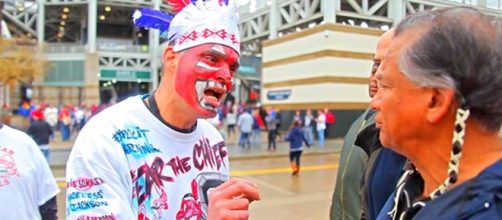The Supreme Court will hear a case on the use of racially disparaging trademarks. In 2014 the US Office of Patent & Trademark cancelled the trademark of the Washington, D.C. NFL football team. The cancellation resulted from massive popular indigenous opposition to the team's use of the R-word, a racial slur against Native Americans. The outcome of the Supreme Court case has significant implications for continuing indigenous opposition to the use of racist sport teams mascots. The general public has an uninformed understanding of the issue. Many will say, 'Aren't there more important issues?' Indigenous activists know that any issue they bring to public consciousness will be dismissed as unimportant.
Racist misrepresentation of indigenous peoples in popular culture and media is a serious issue. It is analogous to historical misrepresentation of blacks. Misrepresentation used to justify segregation and the denial of civil rights. It also resulted in significant psychological damage to African Americans, particularly children.
Show me the brown doll
Many are familiar with the infamous US Supreme Court decision in Brown v. Board of Education, that ended racial segregation in US public schools. What few are are familiar with is the expert testimony of Dr. Kenneth B. Clark and Mamie Phipps Clark. The infamous “doll test” in which Dr. Clark showed black children toy dolls of different races. In Arkansas, Dr.
Clark received a “disturbing result.” He asked a black child to identify the doll that was most like him. He pointed to the doll and stated, “That's an N-word. I'm an N-word.” In the same test in Massachusetts children would cry and run out of the room when asked which doll was most like them. Dr. Clark's test showed that the extreme racism against African Americans in the 1950s led to self-hatred among black children. The racism took many forms. White performers dressing in racist “blackface” makeup and mocking African Americans through stereotypical speech and actions was one. Racist imagery of African Americans was also quite common in popular art, such as corporate logos and trademarks. This served to dehumanize African Americans to the degree that many whites believed segregation justifiable.
We no longer tolerate racist misrepresentation of African Americans in our society. For indigenous peoples, it is another story.
Psychological and social impact of racist mascots
In the book “Columbus and Other Cannibals” the late indigenous scholar Jack D. Forbes (Powhatan-Renapé and Lenape) details the story of Mary Shingobe Barstow (Ojibwe). In a Catholic boarding school she saw images in a history book of Indians slaughtering whites. They were described as “savages.” She showed the picture to the Sister, the sister told her she was an Indian. Barstow insisted she was not, and ran outside crying. Seeing this racist, and false, indigenous stereotype had a devastating psychological impact on Barstow as a child.
Present day use of racist stereotypical Native American sports team mascots has a similar effect on today's indigenous youth. This was recognized by the American Psychological Association in 2005, which called for the retirement of all American Indian mascots, symbols, images and personalities in schools, colleges, universities and professional sports teams. That same year, the National Collegiate Athletic Association (NCAA) announced it would ban teams using American Indian imagery in postseason tournaments. NCAA also asserted Indian mascots would not perform at tournament games by 2008. Great progress has been made, and many racist mascots have been retired, but the fight continues. Indigenous peoples still live in a society where it is socially acceptable to dress in racist “red face” makeup and mock indigenous culture through stereotypical speech and actions. It is not acceptable, it is racist. Mascots dehumanize our people, and serve to justify our mistreatment. We are people, not mascots. Red face does not honor us.

